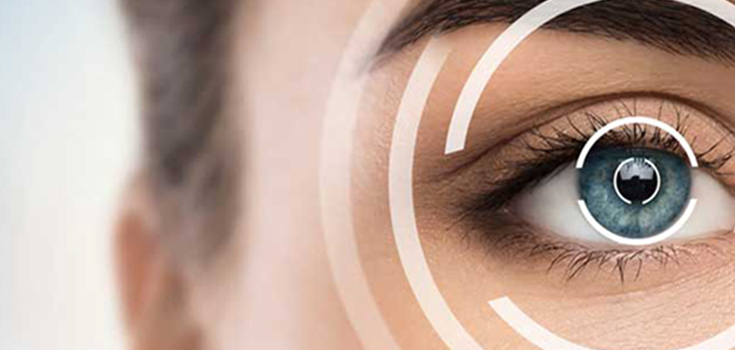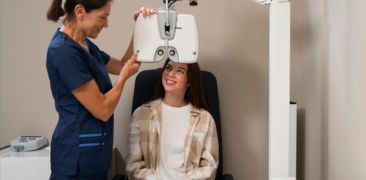Best Cataract Surgery In Delhi
100 % Painless, Bladefree&Stitchless procedure with best Laser Cataract Surgery in Delhi.
- Get Consultation by 30+ Experienced Surgeons
- Hassle-free 20 mins procedure
- Cashless/ EMI/ Insurance options
- 6000+ successful surgeries
Cataract (Hindi: SafedMotia or Motiabind) is age related changes in the natural lens of the eye leading to opacification and consequently causing blurring of vision. It starts after 5th decade of life and usually progresses with the age.The symptoms of cataract can vary according to the area of the lens involved and the blurring is early and more pronounced when central part is opacified as compared to the peripheral part of the lens. The other symptoms may be blurring of vision in bright light(Glare) , Coloured rings around the lights (Haloes), Multiple blurred images of an object (Polyopia), Blurring of vision in dim light, Difficulty in reading and driving, Repeated quick change in glasses power, eye strain and headache etc.Causes of cataract are injury (Traumatic cataract), Diabetes mellitus and various other diseases and thus can occur earlier also. In new born and infants it occurs due to genetic reasons or poor maternal health and diseases during pregnancy and then is called Congenital Cataract.
Now a days, Cataract operation is not disease curing procedure but has become more of a refractive procedure wherein clouded and opacified lens is removed and replaced by premium IOLs (Intraocular lens) implants which allows patients to see at all the distance (i.e. far, near, and intermediate) clearly. We are proud to say that we have successfully performed many surgeries followed by premium lens implantation giving smile on the faces of many satisfied patients.
Reason of Cataract Development
- Ageing: People older than 60 years of age are at the risk of getting cataracts.
- Exposure: Overexposure to UV rays can negatively affect the eyes and cause cataracts.
- Drug-induced: One can get cataracts due to prolonged usage of steroids and other prescription drugs.
- Diabetes: People with diseases like diabetes are more likely to develop a cataract.
- Injury-induced: An injury to the eye can cause cataract or even complete loss of vision
Symptoms of Cataract
- Hazy, fuzzy and blurred vision
- Double vision
- Increased sensitivity to light
- Poor night vision
- Frequent change in eyeglass prescription in the early stage
When Do I Know that I Need Cataract Surgery?
After a comprehensive eye evaluation, our eye doctors will discuss with you the diagnosis of cataract and your best corrected vision (your vision with glasses). They will also help you judge for yourself, with trial lenses, if you are comfortable with this vision with glasses in your day to day life or not.
However, Ifcataract starts blocking vision and performing routine tasks becomes a hassle and you are not comfortable with your vision, the surgeon will discuss with you the best available treatment options at our center in Janakpuri, West Delhi.
Cataract Surgery at RAVI EYE FOUNDATION
We at Ravi Eye Foundation pledge to provide you with complete range of Cataract Treatment starting from Phaco to Latest advanced Laser Cataract Surgery which is performed by our highly experienced cataract surgeons on daily basis. We are well equipped with diagnostics for advanced premium and latest intraocular lenses technologiesso as to provide best possible treatment options for every eye without any discrimination.

Cataract Surgery Options
At Ravi Eye Foundation, we offer youComplete range of surgical options depending upon the severity of the cataract and current condition of the patient’s eyes. However, the best suited surgical option for every individual eye is suggested after thorough testing.
| Regular Sics |
|---|
| Requires an incision of 6-7 mm |
| Slow Recovery |
| Painful |
| Stitches |
| Use of Injections |
| Needs dark glasses |
| Blood loss |
| Phaco Surgery |
|---|
| Requires a small incision of 3.2 mm |
| Fast Recovery |
| Stitchless |
| Foldable Lens Implanted |
| Dark glasses Required |
| No blood loss |
| MICS Surgery |
|---|
| Requires a tiny incision |
| Faster Recovery |
| Stitchless |
| Painless |
| Foldable Lens Implanted |
| No dark glasses |
| No blood loss |
| Robotic Laser Cataract Surgery |
|---|
| Blade-Free cataract experience |
| Working of the laser takes about 30-40 seconds only |
| Greater precision and safety |
| Critical steps of surgery are fully automated |
| A better visual outcome with quicker recovery |
| Allows astigmatism correction also |
Which IOL to Choose?

Choice of IOL (Intra Ocular Lens) depends on your specific needs. If you do not mind wearing spectacles after cataract treatment, then a monofocal lens implant can be used. Usually, people use glasses only for reading purposes after the surgery.
If you do not want to wear spectacles after cataract surgery, then you can opt for presbyopia correcting IOLs.
By choosing for advanced presbyopia-correcting IOLs, you can improve your reading vision without compromising on distance vision. You can select presbyopia-correcting IOLs which includes accommodating IOLs and multifocal IOLs for a greater range of vision.

Monofocal Lens
These were the most commonly used intraocular lenses up until multifocal lens were invented. Monofocal lenses have the ability to focus light rays for either distance or reading, hence after getting a monofocal lens implantation, a reading glasses are often required.
Multifocal lenses
They ensure good quality vision and eliminate the need for corrective glasses. They help patients see for most distances with minimal requirements of glasses.However, they are not suitable for night time driving as they might produce some amount of glares and halos.Therefore, suitability of these lenses can only be decided upon by your surgeon after a thorough examination.
Trifocal IOLs
Trifocal lenses offer clear vision at an intermediate level (generally an arm length). These lenses correct both near and far vision also. The most significant advantage of trifocal lenses is they allow the person to switch effortlessly between near, far, and intermediate distances.

EDOF IOLs
It is a new technology that helps in the treatment of presbyopia. EDOF lenses create a single elongated focal point to enhance the depth of focus. It enhances the sharpness of vision at near, far and the in-between distances.
Toric IOLs
These IOLs correct the pre-existing corneal astigmatism there by reducing the possibility of spectacle wear for distant vision post operatively.
ASPHERIC IOLs
These IOLs gives good quality of vision post-operative due to the lens design, it also improves the contrast sensitivity of the patient and good night vision. These lenses also filter the harmful UV light and blue light which are said to be harmful to the retina.
ACCOMODATING IOLs
These IOLs have flexible hinges that enables them to change focus for different distances hence providing clear distance, intermediate and near vision without glasses.
A cataract is an opacification of the natural transparent lens causing blurry, cloudy, or distorted vision. It usually occurs as normal aging process. The human lens is located just behind the iris, or the coloured part of the eye. A healthy lens is clear and flexible, allowing us to see focused images. The original meaning of "cataract" is “WATERFALL”, because the type of visual defect seen from cataractious eye is similar to as if you seeing through a waterfall.
Usually Cataract occurs in 50% of people by the age of 65 and in 95% by the age of 75. So, practically anybody and everybody can develop cataract, who lives long enough, so they are considered a normal part of the aging process, similar to greying of hair and aging of skin. Diabetes, steroid use, trauma, smoking, excessive alcohol consumption, obesity, hypertension excess levels of bad cholesterol (LDL) in the body and excessive sunlight or radiation exposure are certain factors can speed up cataract formation. Cataracts can develop in children due to some genetic or hereditary conditions or due to some problem during development of the foetus.
Generally, many people discover they have a cataract only when they visit their eye doctor for new glasses. But there are some visual (symptoms) problems which might help us to know that Cataract is there. Common symptoms of cataracts include blurring of the vision. Colours may appear too dull or too bright and the same is felt for light. The symptoms vary according to the type of the cataract. The nuclear cataract causes a short term improvement in an individual’s vision. This phenomenon called the ‘second sight’. In contrast, sub-capsular cataract fails to exhibit symptoms unless fully developed.
NO. The cataract usually develops very slowly and painlessly, and is age related process. So, we don’t to panic for it. Caution, this Does not mean One should not get cataract removed. One should get it removed in proper time after consulting your Ophthalmic surgeon. If Cataract is not treated, it may turn into complicated cataract, which is very difficult to treat and may even lead to permanent loss of vision.
There are no known medicines to stop or reverse this change. Surgery is the only definitive treatment. Cataract surgery has an overall success rate of 97 percent or greater. With the use latest and advance Techniques developed over the period of time, this surgery has become most safe and with very high success rates.
The Types of Cataract Surgeries done these are SICS, PHACO, MICS and FLACS. Most Commonly done preocedures among these are PHACO and MICS.
During Cataract Surgery, the natural Opacified lens is removed and replaced by new artificial human made lens (called Intra Ocular Lens) through small hole (or an incision). This is done with the use of highly advance machines. The techniques such as SICS, PHACO, MICS, and FLACS mainly differs in incision made through which opaque natural lens is removed and new Lens is inserted.
A Typically Uncomplicated cataract surgery often takes no longer than about 10 to 15 minutes to perform. But immediately after the surgery, you will need to rest in a recovery area until you are less groggy from anesthesia. Typically this takes about 30 minutes to an hour.
For a safe and fast recovery from cataract surgery, take following precautions:
- Use Dark Glasses for a week after surgery.
- Take your medications and eye drops as prescribed your doctor for smooth recovery.
- Avoid sneeze or vomit right after surgery.
- Don't do any heavy lifting or strenuous activity for a few weeks.
- Don't drive on the first day.
- Avoid bending over, to prevent putting extra pressure on your eye.
- Don't rub your eyes, which is a good idea even when you aren't recovering from surgery.
- Don't expose your eye to irritants such as dust, pollens and wind during the first few weeks after surgery.
- Avoid use of water on face like swimming or using a hot tub during the first week, to reduce risk of infection.
- Be careful walking around after surgery, and don't bump into doors or other objects.
Cataract Surgery is usually performed in one eye at a time. So, if one need’s cataract surgery in both eyes, the eye surgeon will wait for at least a few days to two weeks for your first eye to recover before performing a surgery on the second eye.

